A list of the best Iceland towns and historic places to visit is necessary to better understand their unique history and culture. Due to the amount of volcanic activity in its past, and present, much of the “land of fire and ice” is uninhabitable. Iceland’s population (c. 2022) is around 375,000 making it the lowest population density in all of Europe and 5th least in the world. In those towns where people have chosen to live take on individual personalities of their own driven significantly by weather and local geological conditions. More than 95% of Icelanders live in the few urban areas around the island with a third of those living in Reykjavik alone.

Iceland’s history is unique and familiar at the same time. The earliest documented people in Iceland dates back to the 9th Century. In 930 they created a General Assembly and in 1000 they officially became a Christian nation. Iceland was incorporated into Norway late in the 13th Century and didn’t officially become an independent republic until 1944, though it had been pretty much autonomous since early in the century. Because of their relative physical isolation Icelanders have the unique distinction of still speaking in their original language, Old Norse. As we explore the best Iceland towns and historic places to visit, we’ll follow the Ring Road from west-to-east and south-to-north.
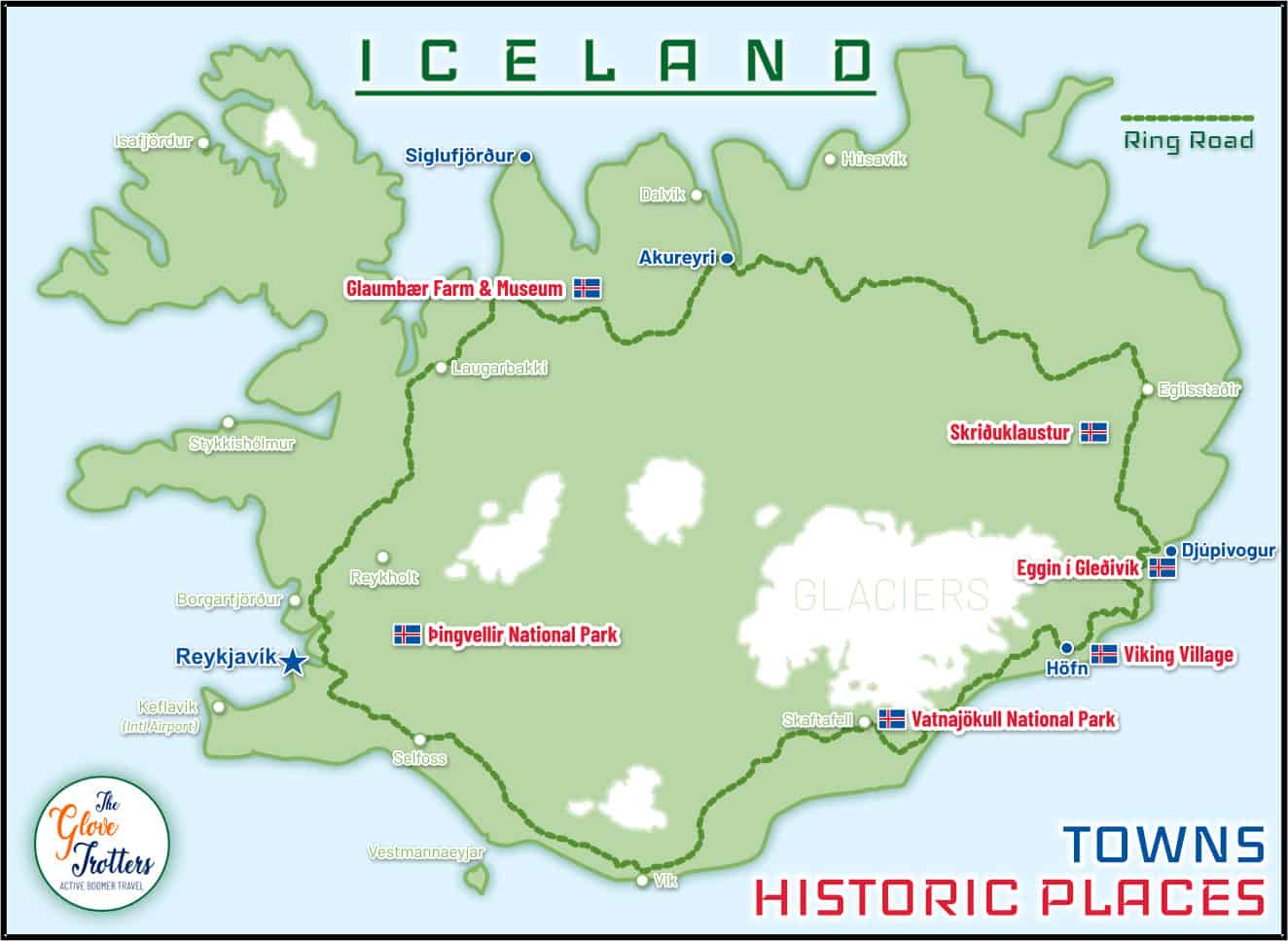
Jump to a specific area.
Reykjavik
Pronounced: rake • ya • veek
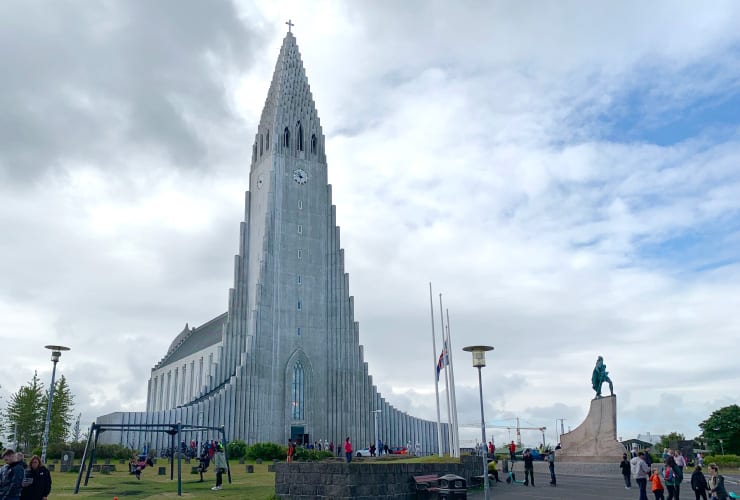
Reykjavik is the capitol of Iceland and far and away the most populous city. It was the first settled area of Iceland and the de facto cultural center. Reykjavik is a melting pot city and certainly one of the best Iceland towns and historic places to visit. It is, in fact, so important to the Land of Fire and Ice that it deserves its own article.
Höfn
Pronounced: huf
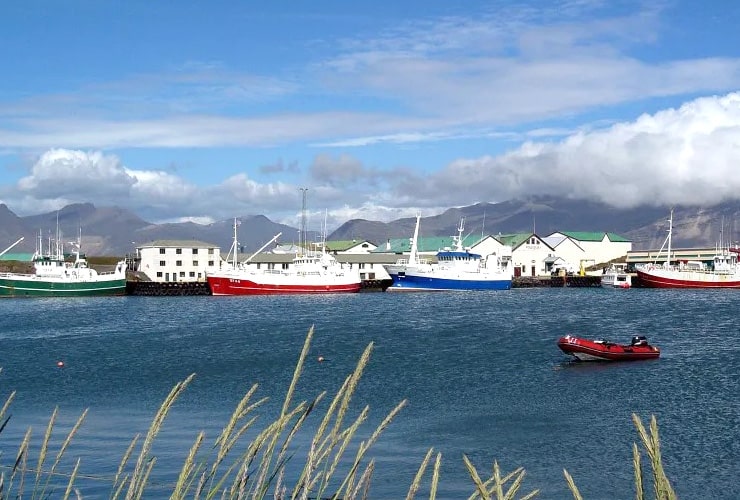
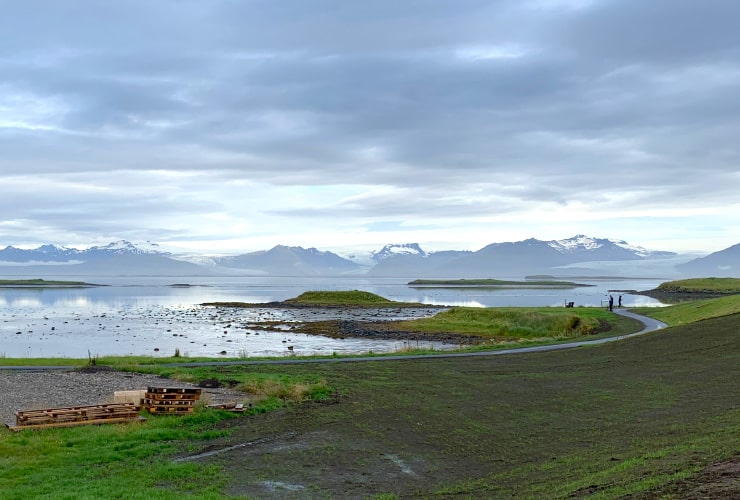
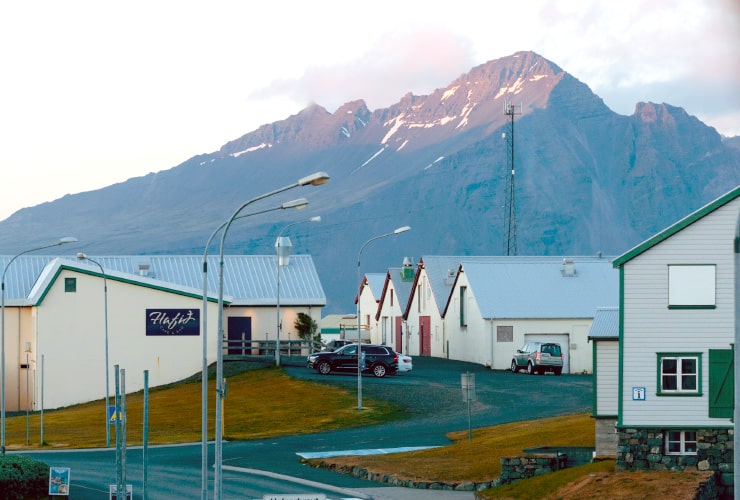
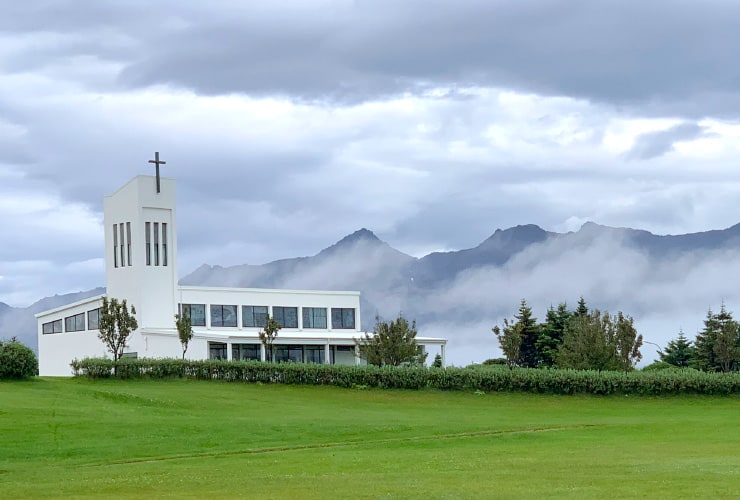
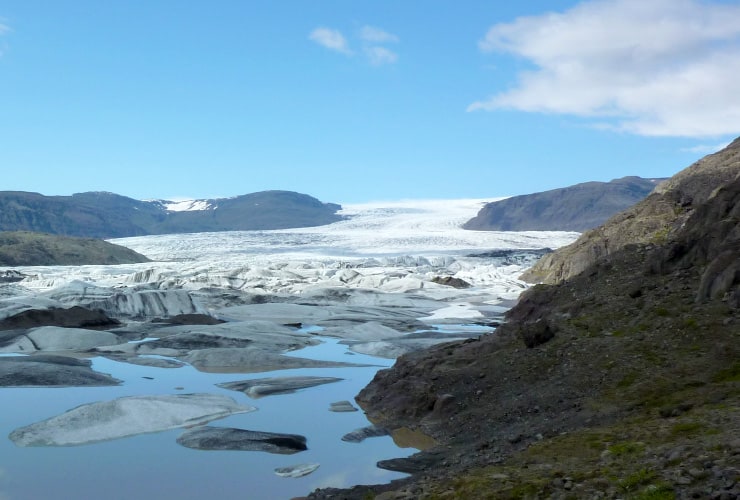
Höfn (meaning harbor) is the second largest town in southeastern Iceland and is best known for its harbor, views of the Hoffellsjökull finger of the infamous Vatnajökull glacier, bird watching and the Lobster Capital of Iceland. With a year-around population just north of 2,000 Höfn is more of a village than a town and it prides itself on having that small town charm and warmth. Only settled a few centuries ago, Höfn just officially became a town in 1988. There are several museums, shopping, restaurants and a colorful (and busy) harbor. From Höfn you can arrange day trips to hike the glacier, take a boat tour on a glacier lagoon or explore an ice cave.
Djúpivogur
Pronounced: tune • pee • ro • ush
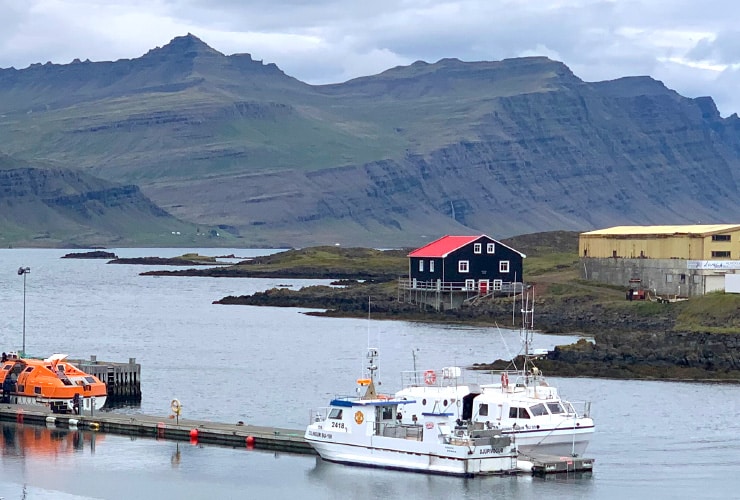
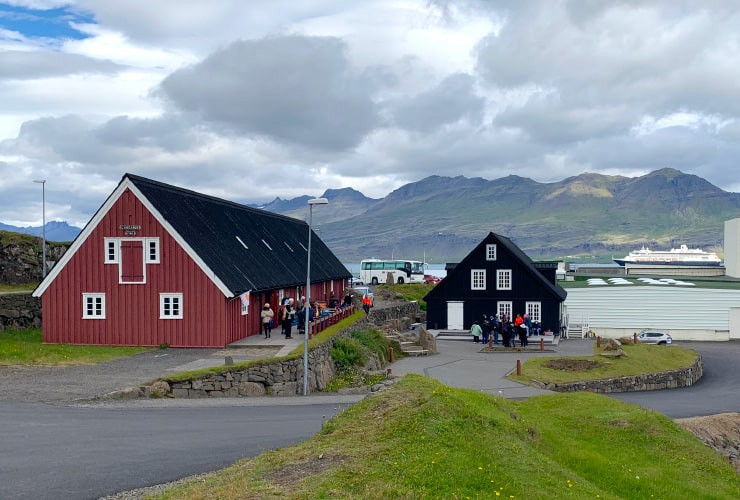
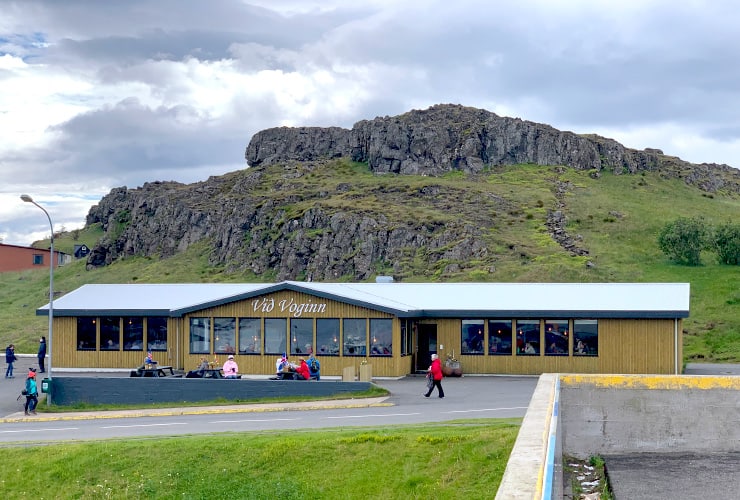
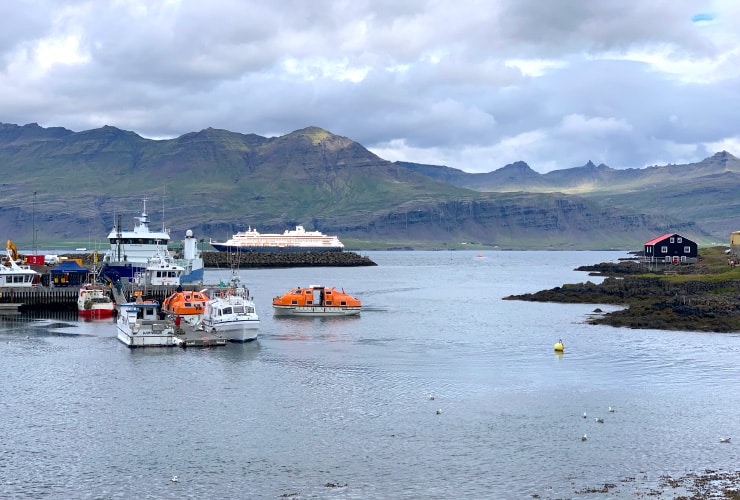
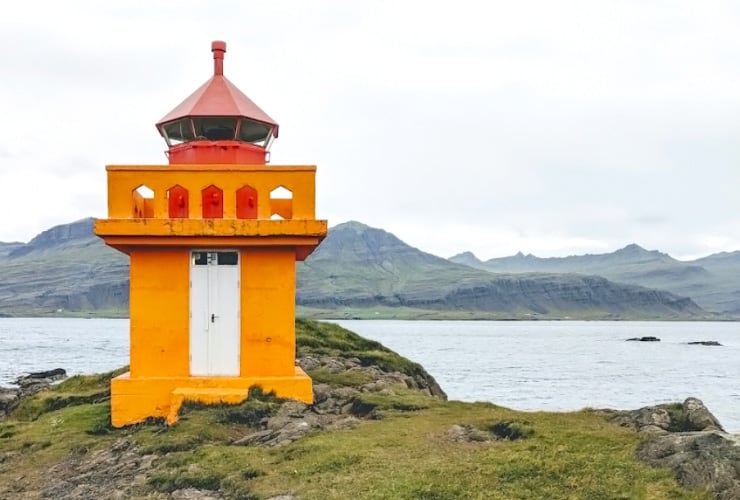
Nestled into the Búlandsnes peninsula in eastern Iceland is one of the best Iceland towns and historic places to visit, Djúpivogur. This tiny little hamlet is home to less than 500 year around residents yet is also a port for Norwegian cruise ships. Traditionally a fishing village, Djúpivogur has become a favorite of tourists. The harbor is small but the coastline has character and spectacular views of the Berufjörður fjord and its towering snow-capped (most of the year) mountains. As you stroll around downtown, make sure to have lunch at Vid Voginn (it can get quite busy but worth it) and visit the different pieces of art on display. With its signature red-roofed, black home dotting the east side of the harbor to the art of Eggin í Gleðivík and the bright orange Æðarstein lighthouse this quaint “Cittaslow” town is worth a visit.
Akureyri
Pronounced: ah • kure • rare • ree
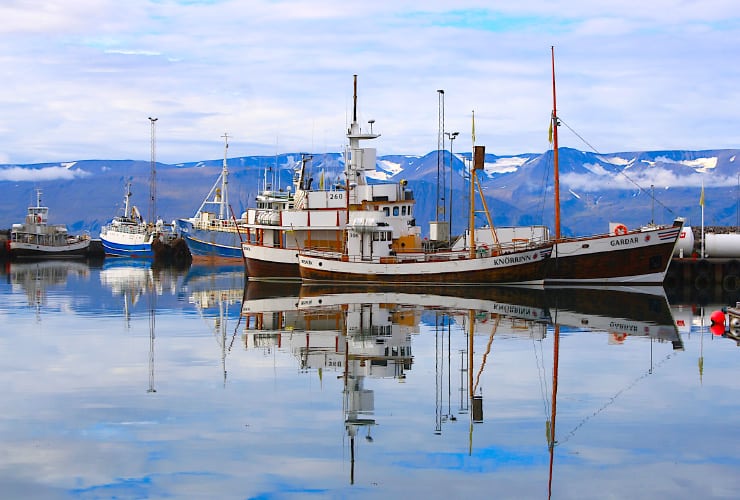
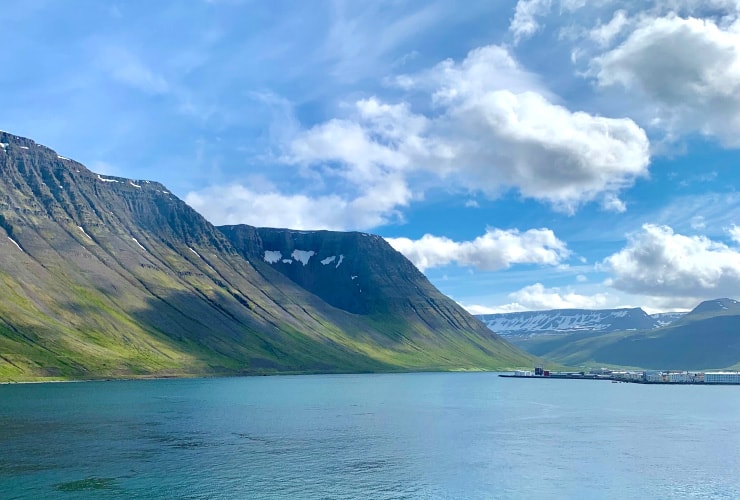
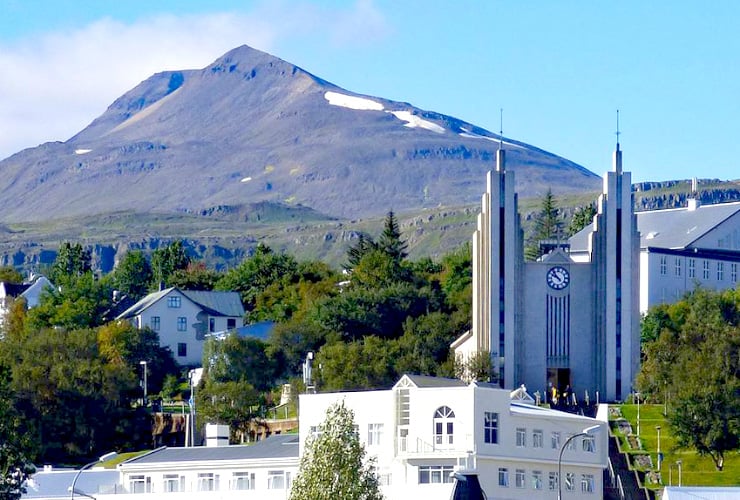
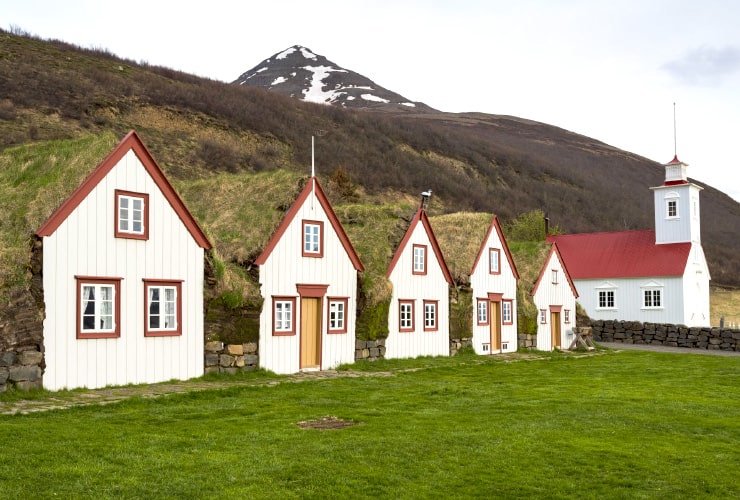
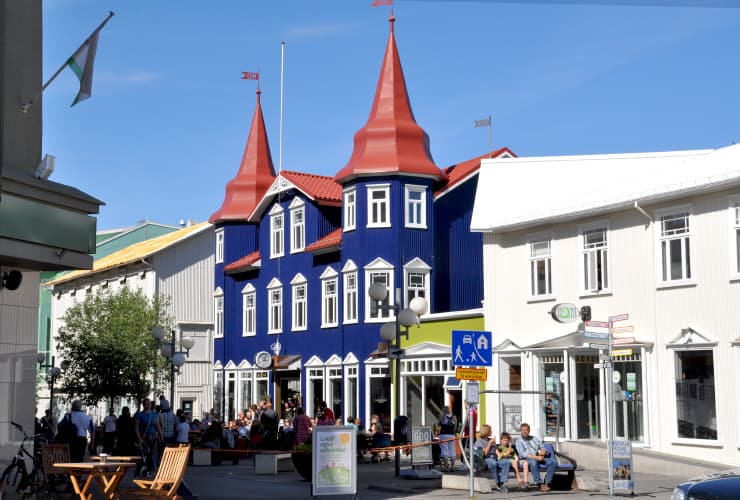
Sitting at the base of Eyjafjörður Fjord in northern Iceland Akureyri, the so-called Capital of the North, is the 5th most populous Iceland town with around 18,000 full-time residents. Locals will tell you the skiing makes this one of the best Iceland towns and historic places to visit. The island Grímsey, part of the town of Akureyri, is situated just inside the Arctic Circle meaning during solstice the sun is constantly above or below the horizon for 24-hour cycles. Akureyri is home to Lystigarðurinn the world’s northernmost botanical gardens, the iconic white marble Lutheran church Akureyrarkirkja, Laufás turf houses and, anytime between August and May, the Northern Lights. The downtown area is quaint and filled with wonderful shops and restaurants.
Siglufjörður
Pronounced: sick • clue • fairy
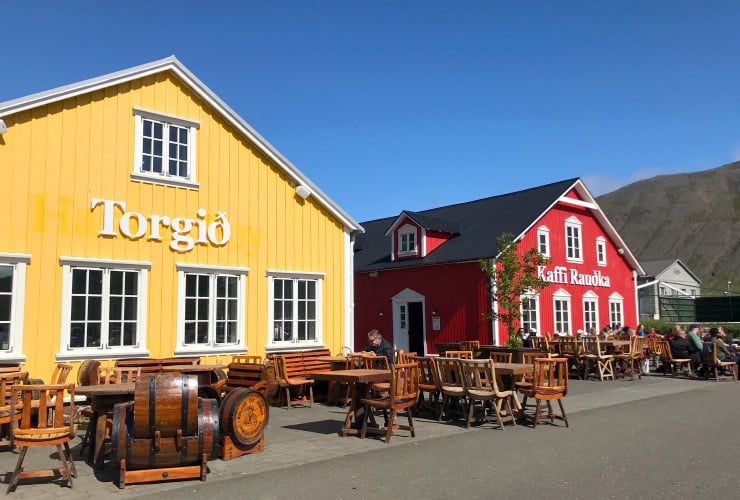
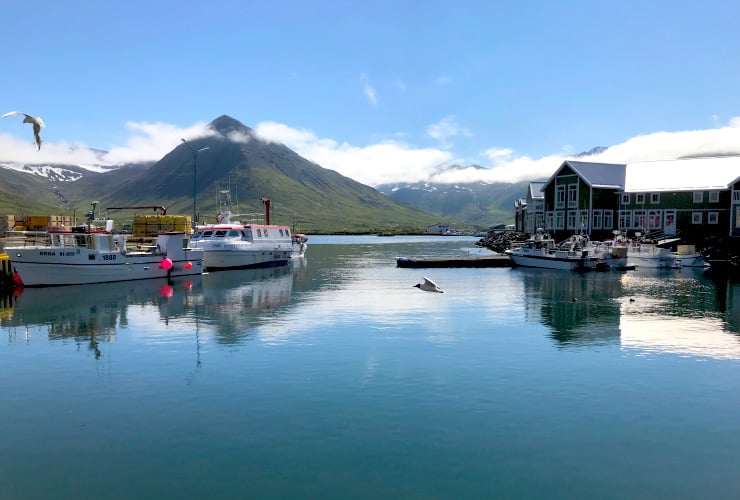
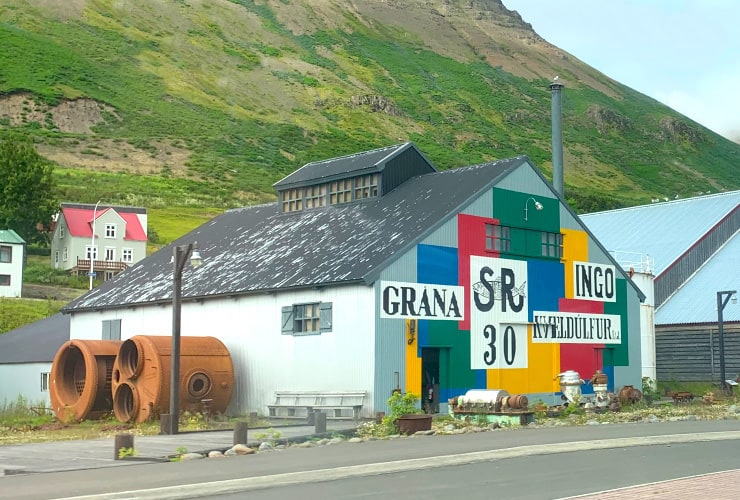
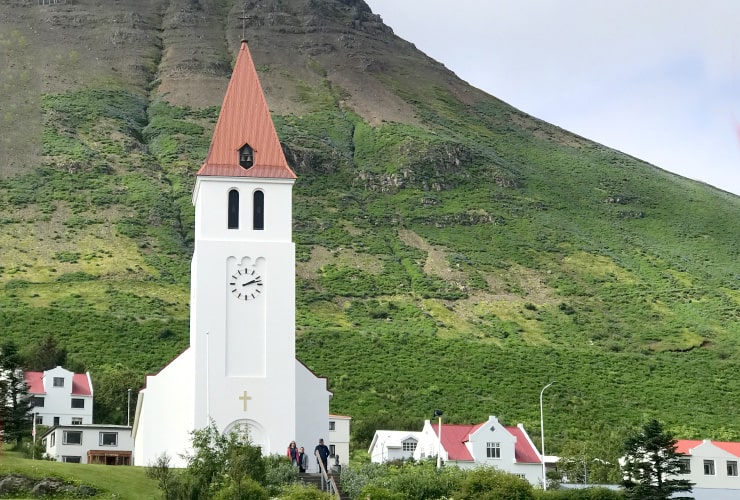
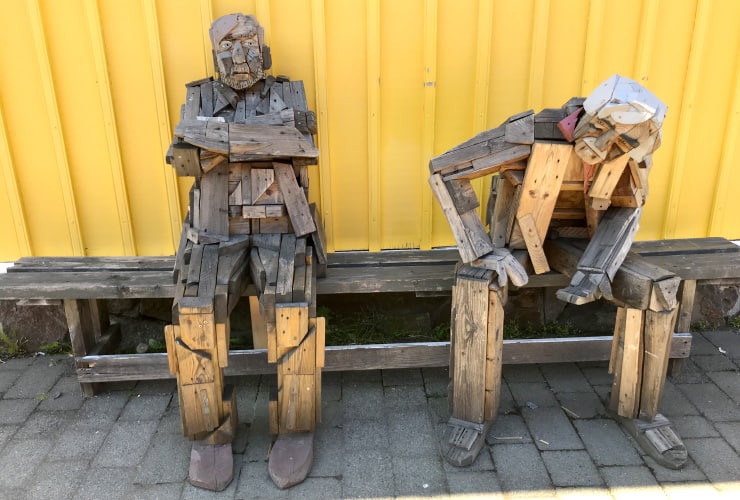
Siglufjörður is the northernmost town on our list and arguably the most beautiful. The town, particularly the Siglufjörður Marina Village, is bathed in color with homes and shops reminiscent of the Painted Ladies of San Francisco. There is a lively working harbor, the Herring Era Museum, the 1932 landmark Lutheran church Siglufjarðarkirkja and the wonderful wooden figures created by Aðalheiður S. Eysteinsdóttir sitting along the east side of Hannes Boy Restaurant. Siglufjörður is located in the Troll Peninsula and surrounded by the Trollaskagi mountain range, Iceland’s largest. Because of its proximity to the Arctic Circle you can enjoy the Northern Lights in the winter and the “midnight sun” for a few months in early summer (June-July).
Þingvellir National Park
Pronounced: fing • grab • fish
Þingvellir National Park is on our list of the best Iceland towns and historic places to visit for its symbolic significance in Iceland’s early settlement. Þingvellir is the location of the first Alþingi or assembly of judicial authority that developed the laws and rulings that guided the country from 930 AD to 1271. This assembly took the place of the constant, and destructive, warring of chieftains as well as a more even distribution of power throughout the entire nation. This allowed the Icelandic culture to begin to develop common customs and a sense of national identity.
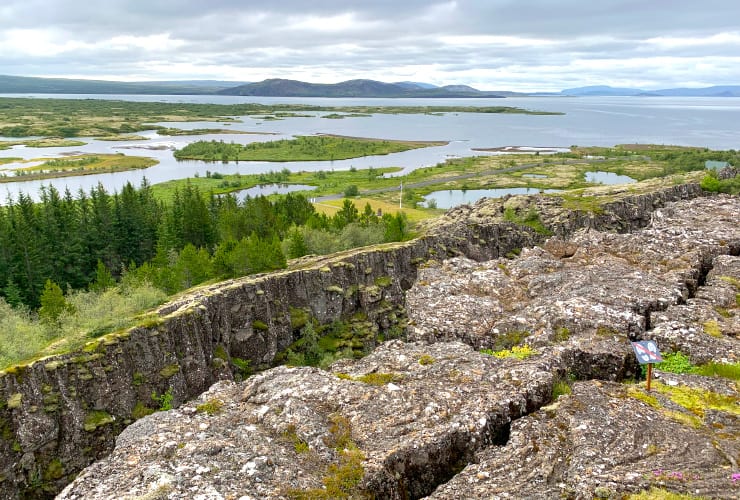
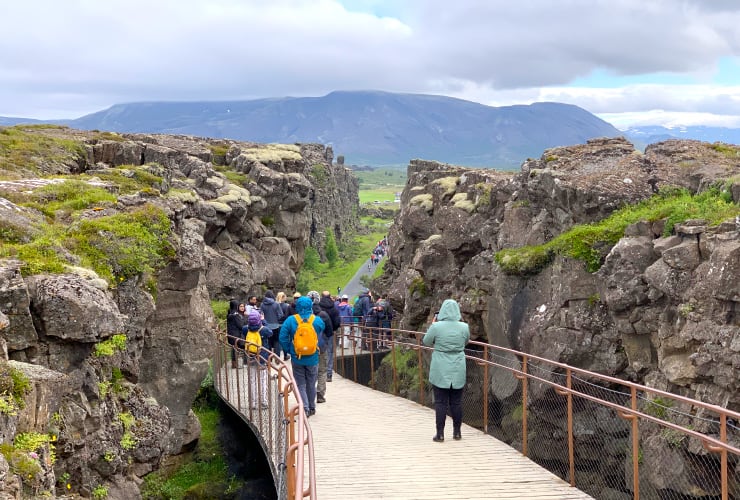
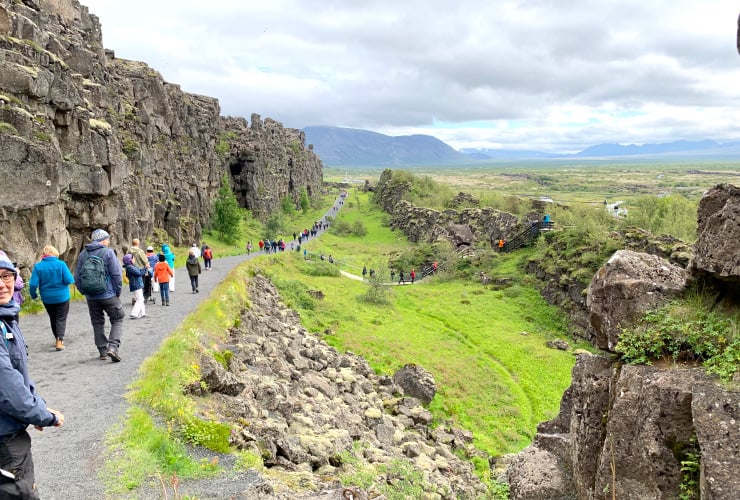
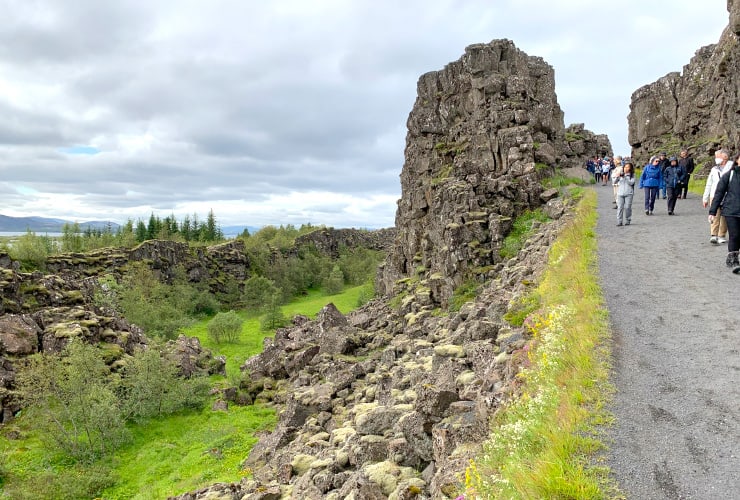
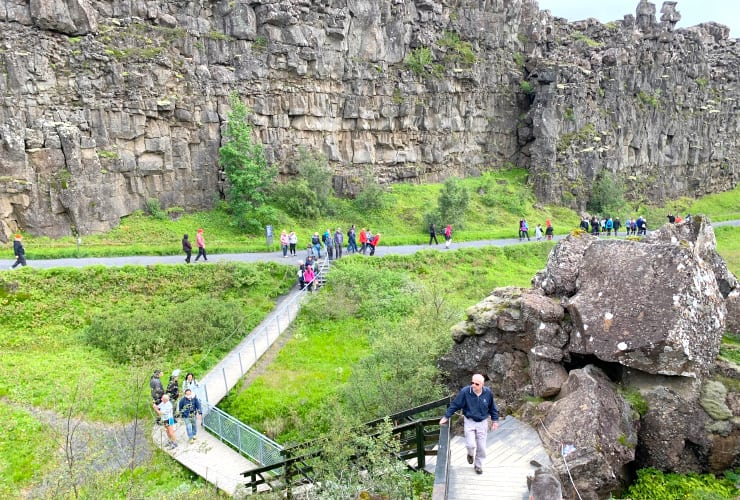
Ironically the land that Þingvellir sits on originally belonged to a man found guilty of murder which made the property a public possession. The close proximity to the largest town (Reykjavik) and relative closeness to all populated areas plus the unique physical structure of Þingvellir made it ideal for large meetings. One of the more monumental events at Þingvellir occurred in 1000 when Iceland decided to officially become a Christian nation. Eventually Iceland became unable to control the individual chieftains which led to its being absorbed into the Norwegian sphere of influence then ultimately Danish rule in 1662.
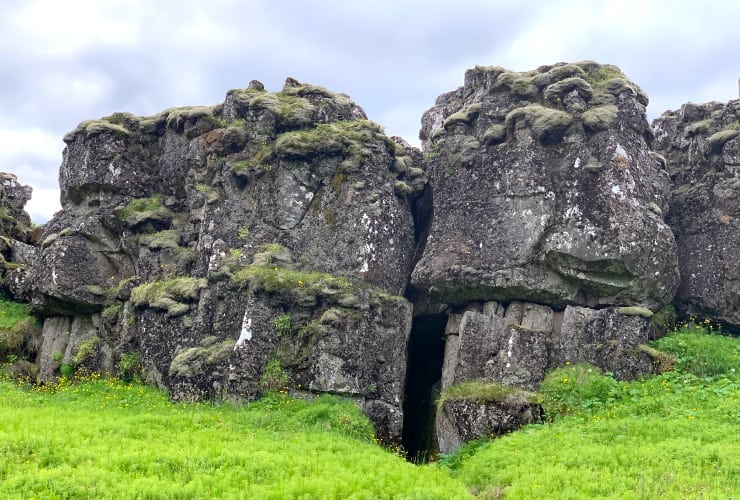
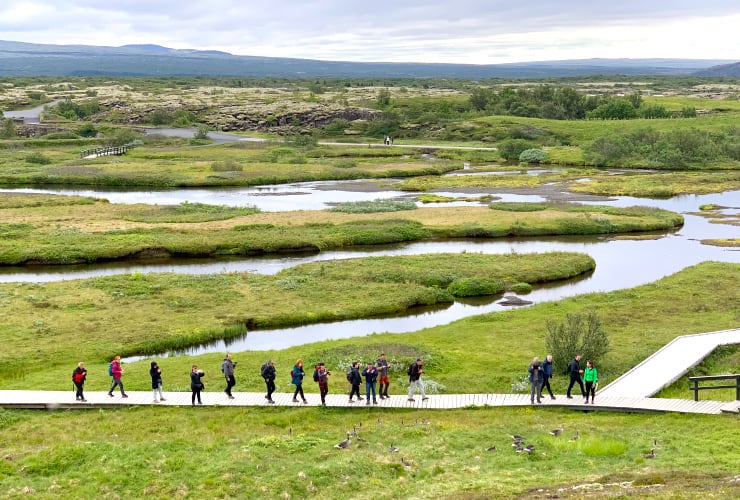
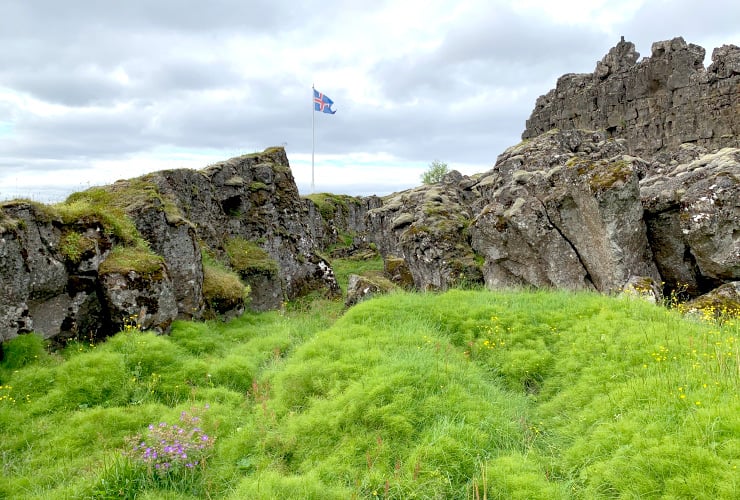
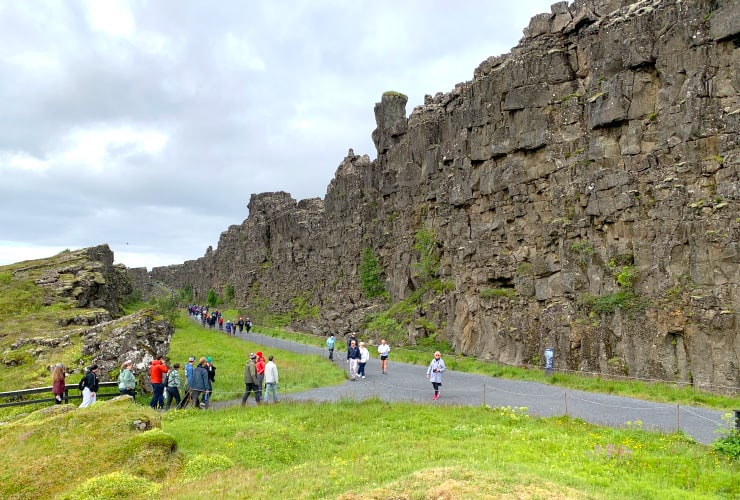
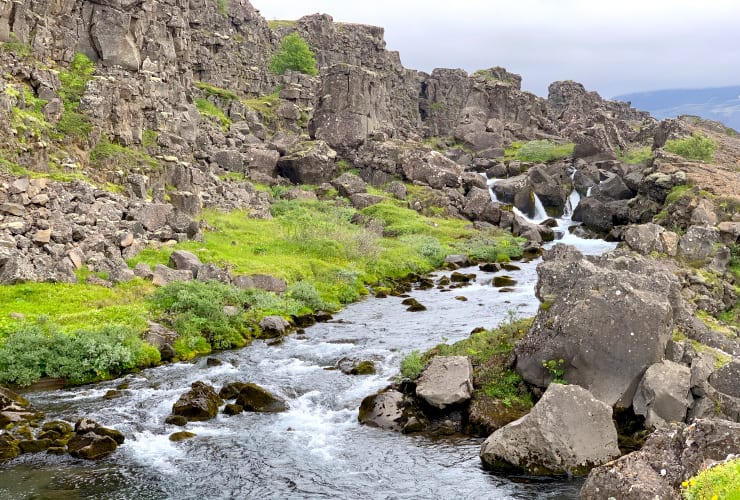
Þingvellir became a national park in 1930 to symbolically celebrate the 1,000 year anniversary of the first Alþingi. It subsequently became a UNESCO World Heritage Site in 2004. Even if there were no historical significance to Þingvellir it would still be a popular destination spot. It is the only place in the world where the rift between two tectonic plates (North American and Eurasian) is above sea-level and so visibly clear. As you descend down the main pathway you are quite literally looking at the edge of North America. If you drive through the park you can see the Eurasian side with the rift valley in between. There is a wonderful gift shop, full facilities and, as you make your way to the lower parking area, a fantastic cascade to enjoy.
Vatnajökull National Park
Pronounced: vock • na • ear • kooch
The Vatnajökull National Park, located in the southeastern portion of Iceland, covers over 5,460 mi2 (14,141 km2) which accounts for an astonishing 14% of the entire landmass of the country. While the park features breathtaking mountain ranges, active volcanoes and vast wetlands it is the Vatnajökull glacier that dominates not just the landscape but also the interest of Icelanders and tourists alike. It is the largest glacier in Europe covering an astonishing 2,973 mi2 (7,700 km2) with an average ice thickness of 1,500’ (457 m).
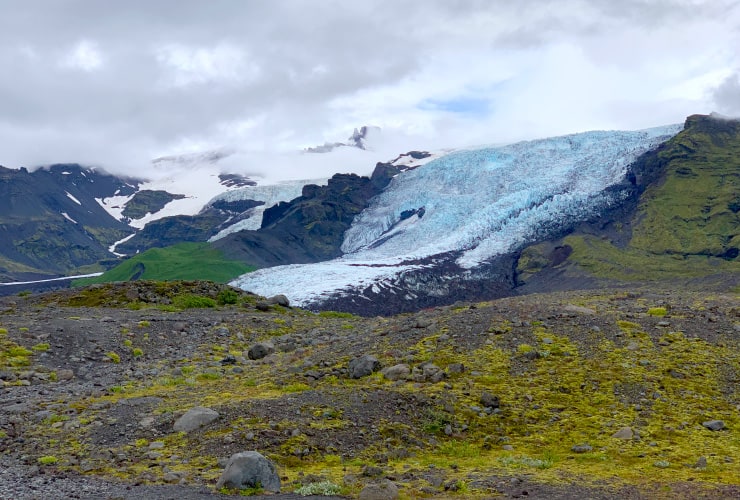
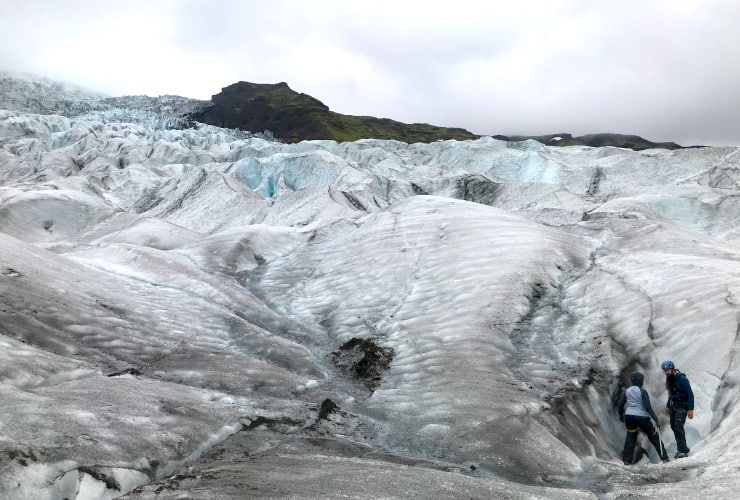
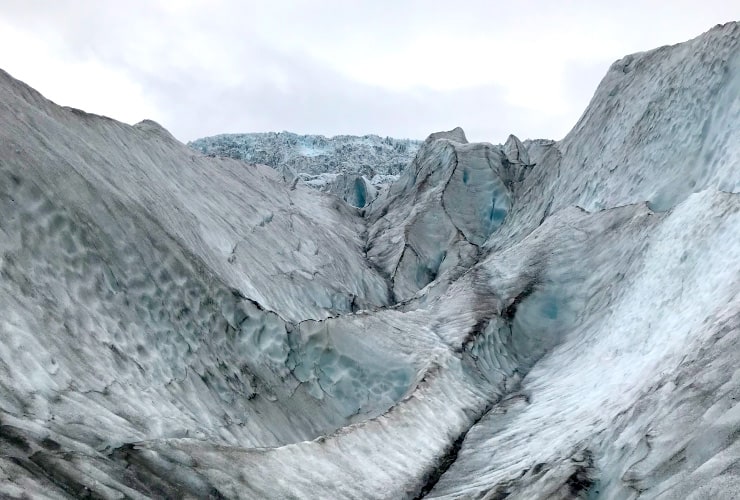
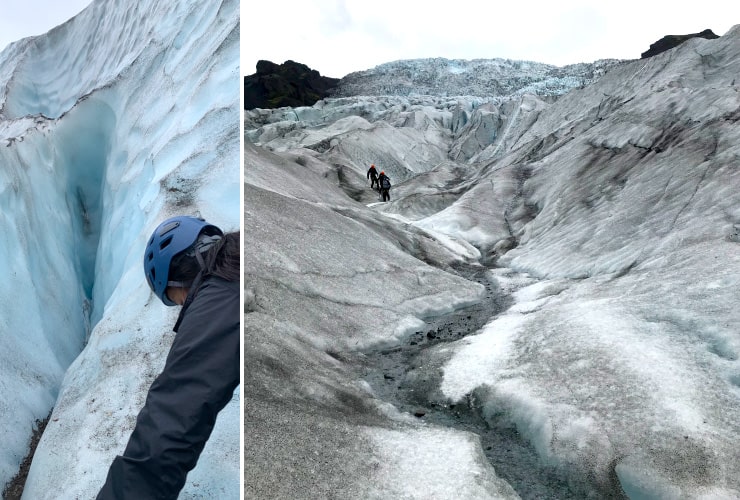
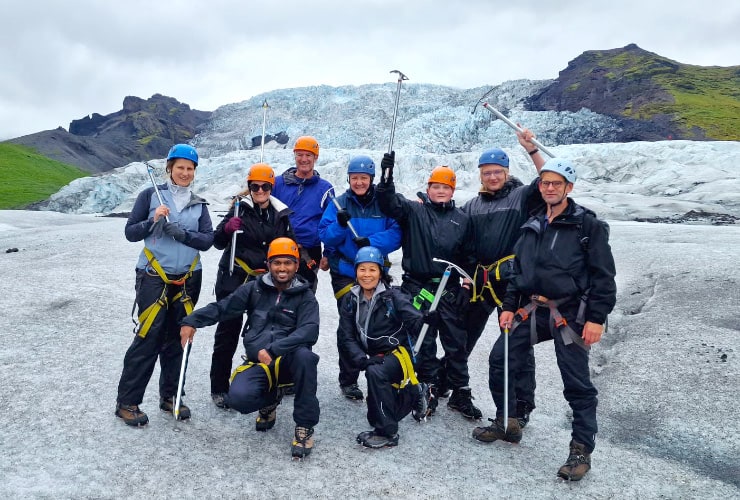
Beneath the Vatnajökull glacier is the tallest mountain in the country, Hvannadalshnjukur (6,923’ or 2,110 m), as well as (7) volcanoes including (3) of the islands most active in Bardarbunga, Grimsvotn and Oraefajokull, each of which are expected to erupt within the next 50 years. The glacier itself has (40) fingers or outlets that extend off the edges and there are countless trails that are traversed on a daily basis. We had the thrill of hiking up Svinafellsjökull glacier with a group of (9) that included our Italian/Australian guide, Franchesco.
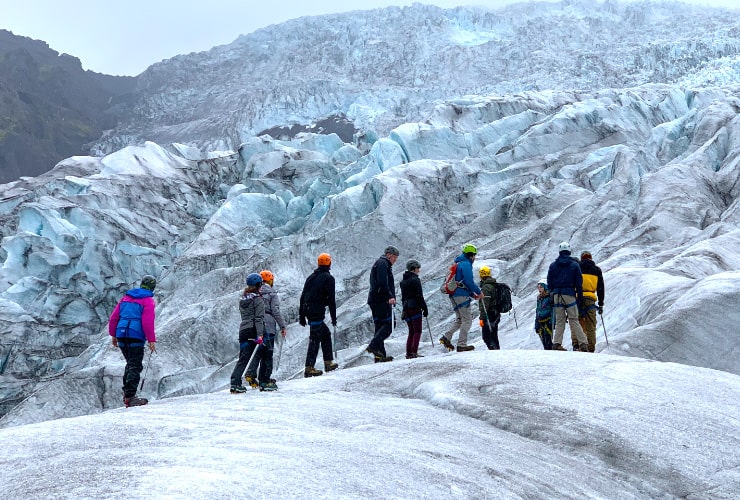
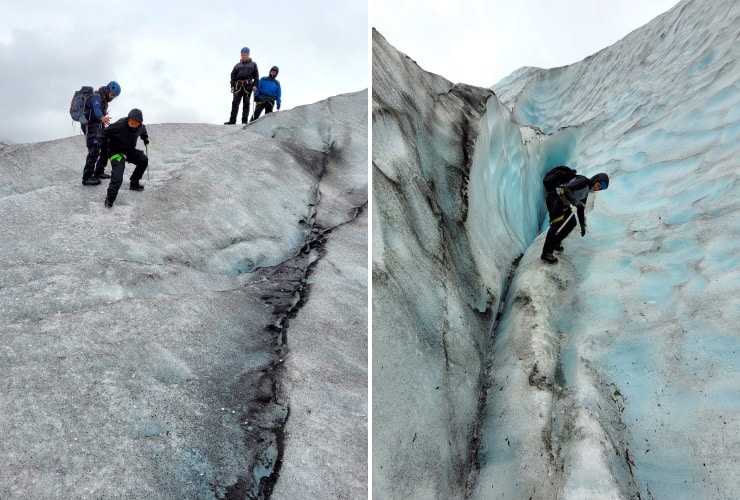
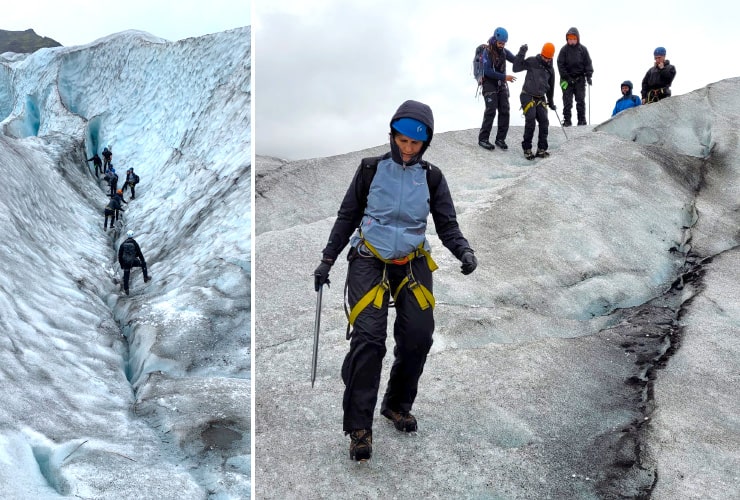
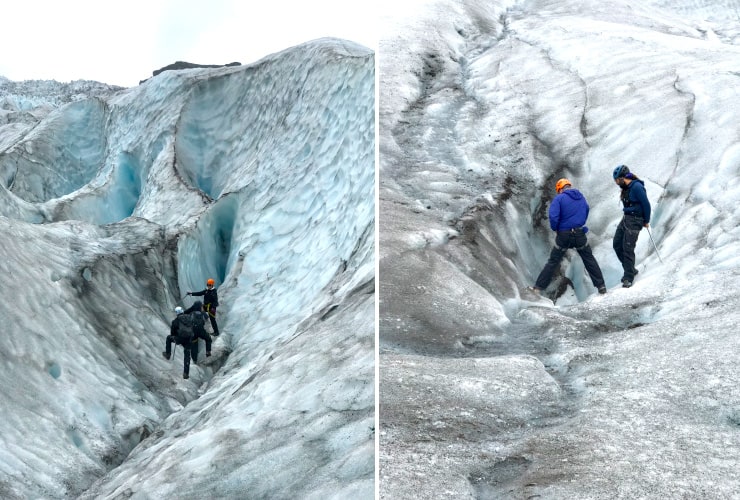
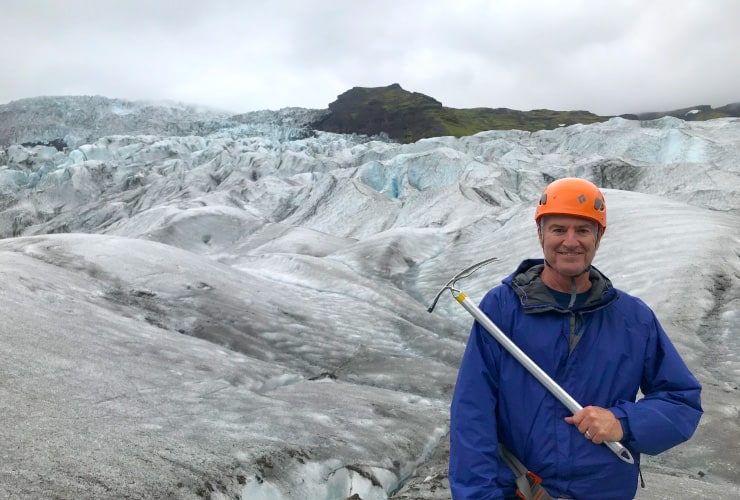
The most difficult part of the hike was getting up to the glacier itself. Once on the ice the adventure was phenomenal. Franchesco did an excellent job of not only explaining the intricacies of how glaciers come about and behave but also in finding interesting areas for us to explore. The ice is constantly shifting and morphing on a daily basis so no two trips are exactly the same. We were each equipped with helmets, crampons (strap-on steel cleats for our shoes), harness and ice axes. We learned how to properly identify potential dangerous areas, how to properly walk downhill and a healthy respect for conserving and enjoying this remarkable geological wonder. The Svinafellsjökull glacier is definitely near the top of our best Iceland towns and historic places to visit list.
Viking Village Movie Set
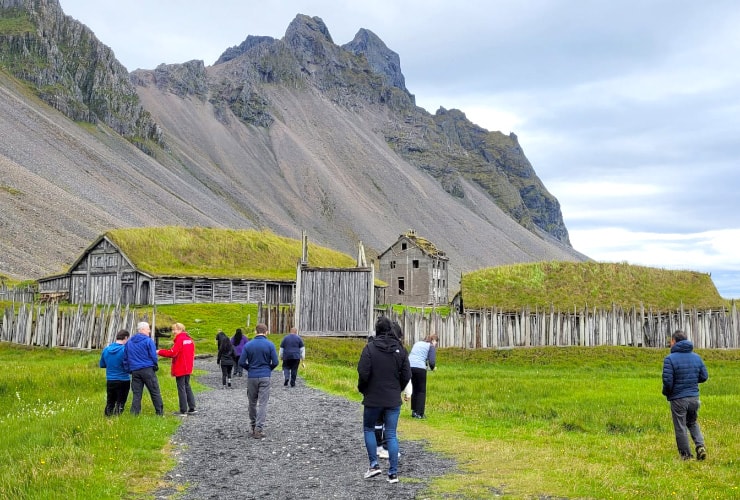
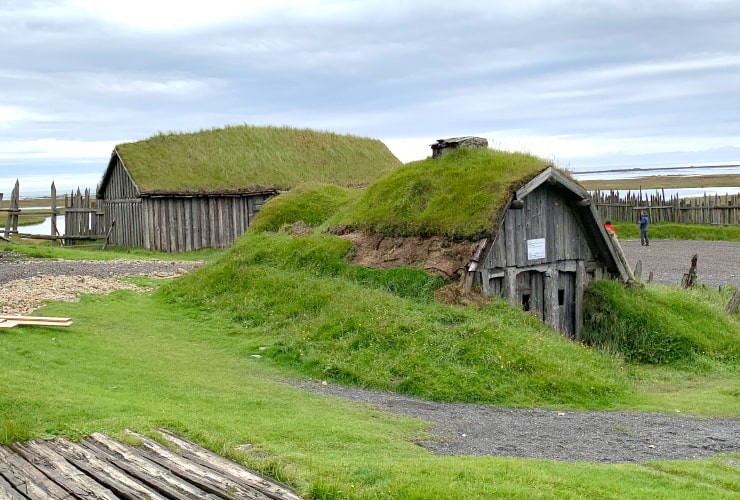
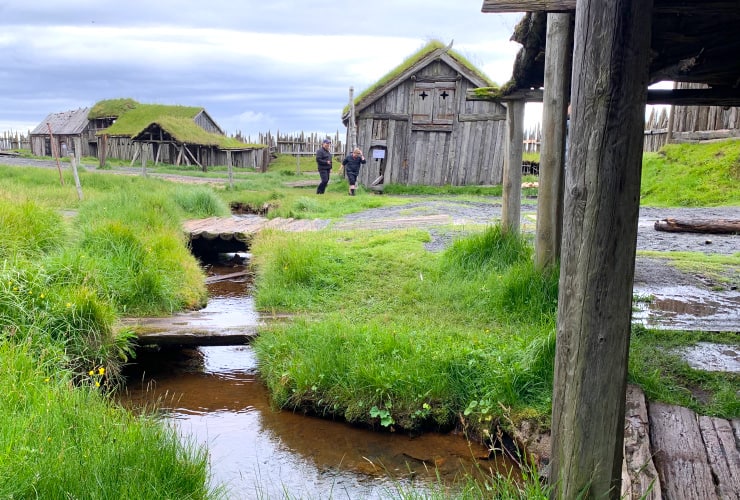
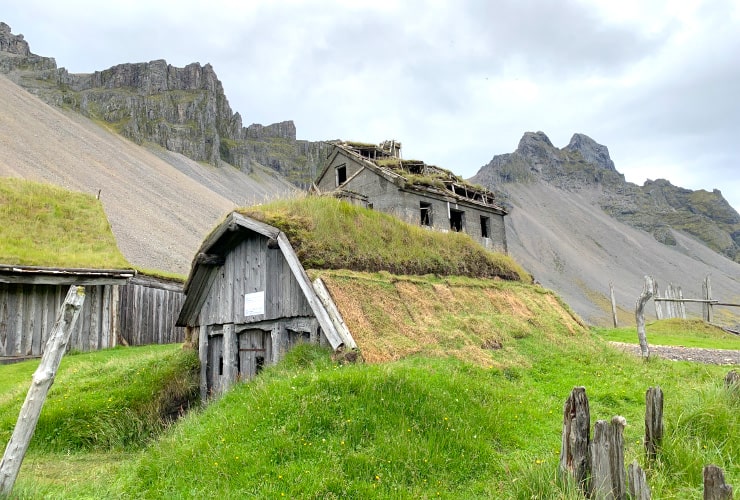
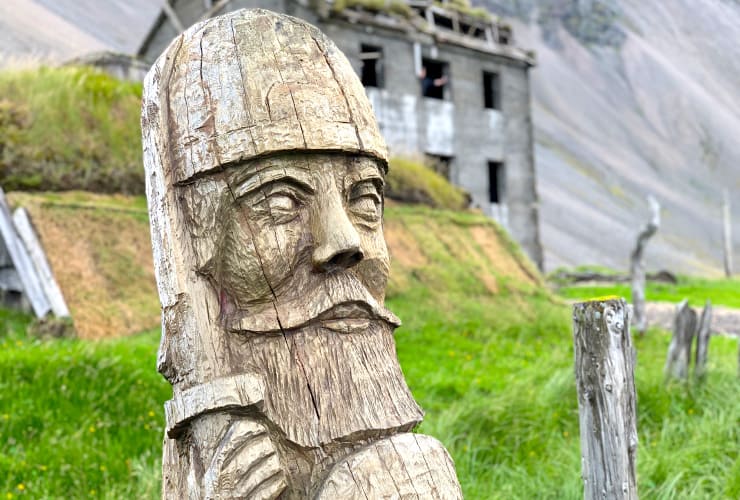
At the base of the remarkable Vestrahorn Mountain is a fascinating Viking village that has an even more interesting story. In 2010 Universal Studios began basic production for an epic Viking film. Much of the initial financing was put into creating an authentic Viking village that included everything from homes and taverns to barns, a town square and even a dungeon. Unfortunately, further financing fell through and production halted.
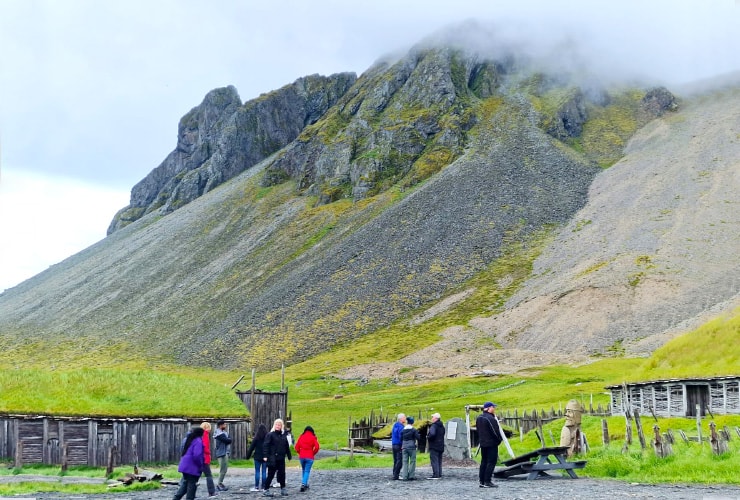
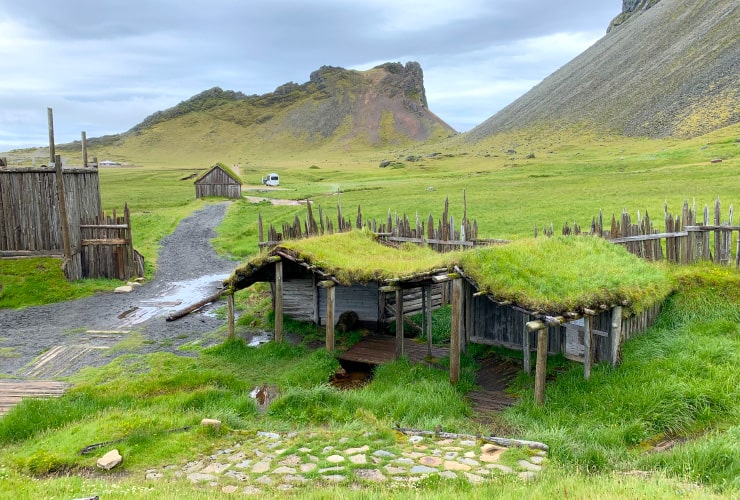
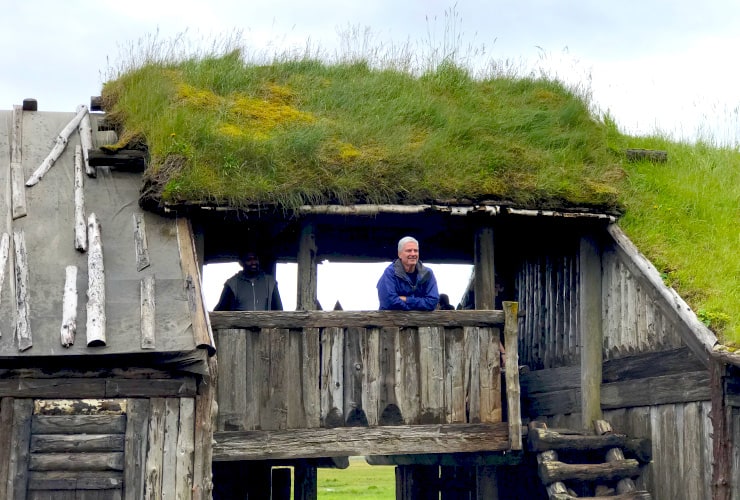
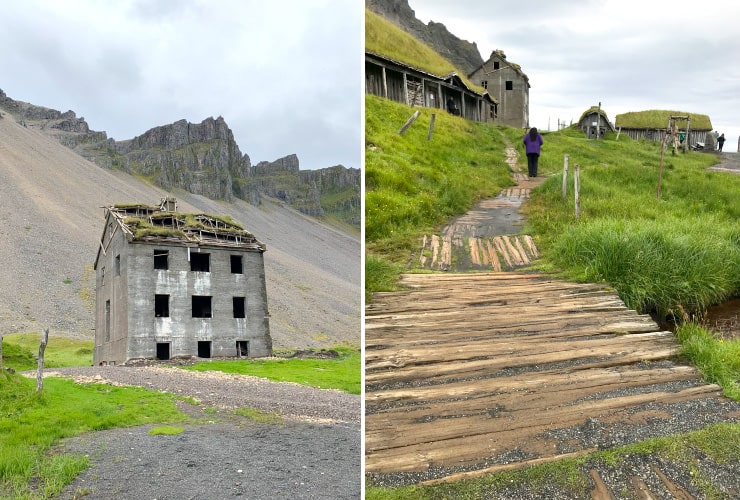
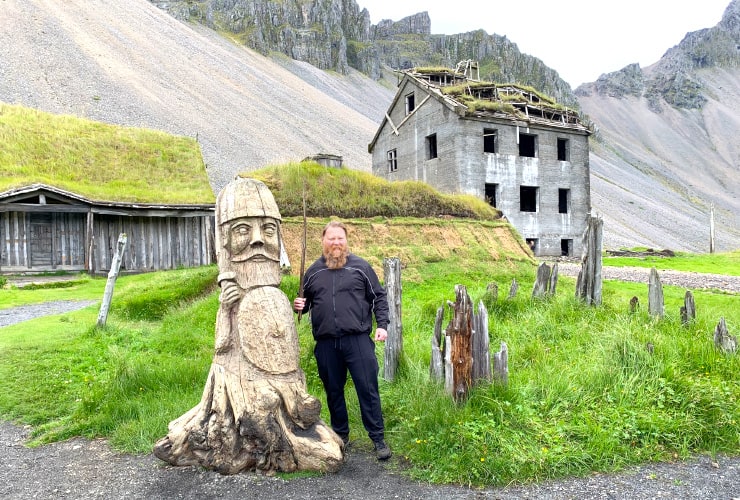
The mountain backdrop and harsh Icelandic weather has contributed to the village’s authenticity with the Laufás turf roofs, weathered wood and overall dilapidation. There are rumors of an Icelandic production looking to film here but only time will tell. An absolute must addition on any list of the best Iceland towns and historic places to visit.
Eggin í Gleðivík
Pronounced: eck • yinee • claire • re • leach
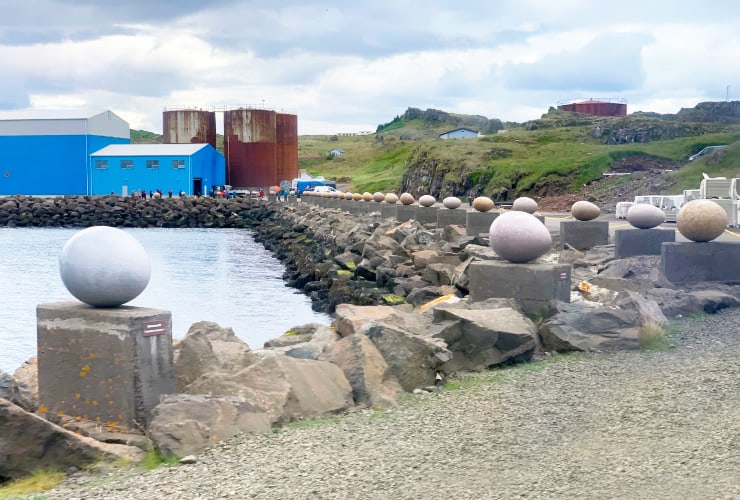
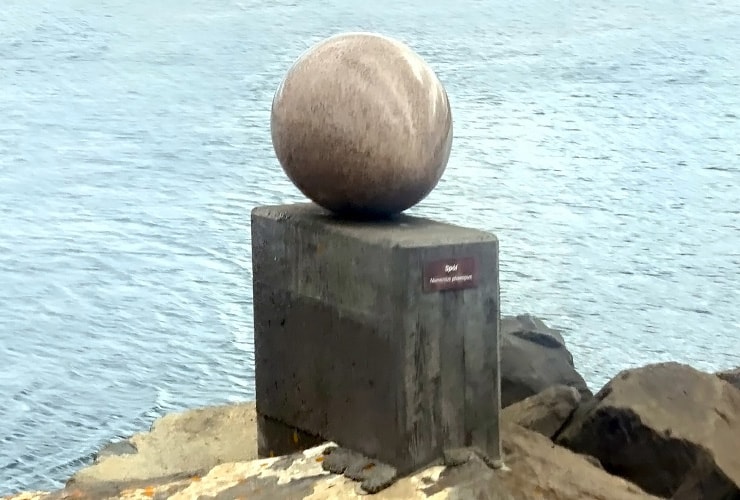
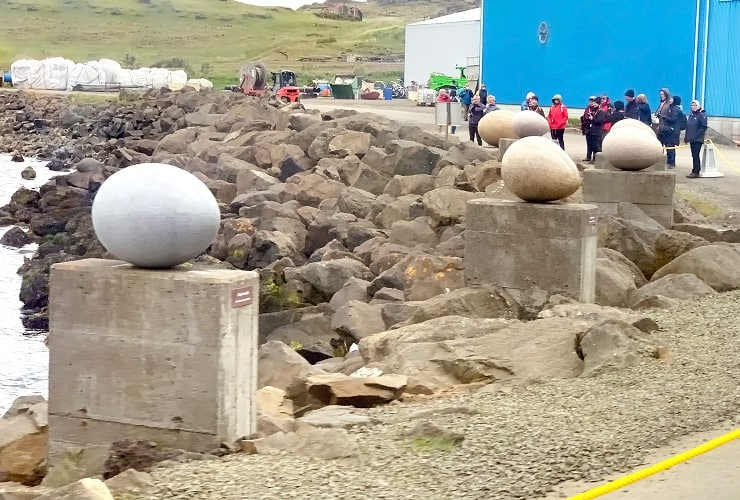
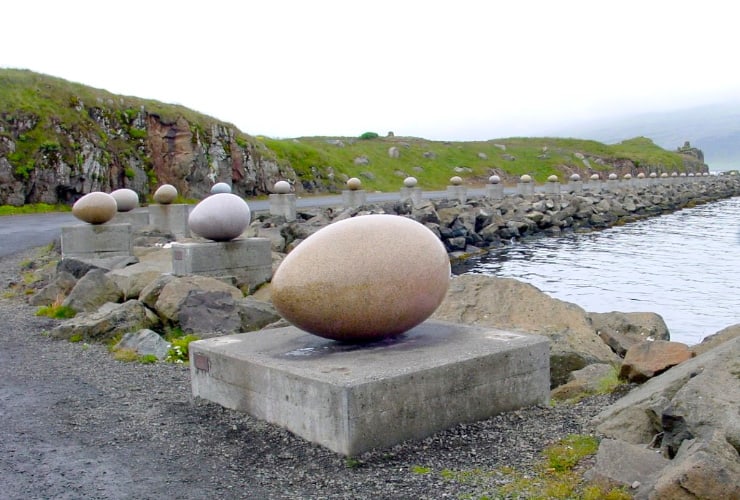
As art, the Eggin í Gleðivík or “Eggs of Merry Bay” is at the observer’s individual discretion and taste. Sigurð Guðmundsson, one of Iceland’s foremost artists, completed the project in 2009 and it has since become one of Djúpivogur’s most visited attractions. When Merry Bay port ceased its fishing operations the unused molten plinths became a local eyesore. Instead of removing them Djúpivogur’s District Manager came up with the idea of converting the area into something memorable. He contacted Guðmundsson and the rest is history. The over-sized granite eggs represent the 34 different nesting bird eggs in the region and are proportionately sized though the red-throated diver, the official bird of Djúpivogur, is larger than the others. On each plinth is the zoological name of each bird as well as its Icelandic name. Not a personal favorite but worth a visit if you’re in town.
Skriðuklaustur
Pronounced: skree • you • clush • tish
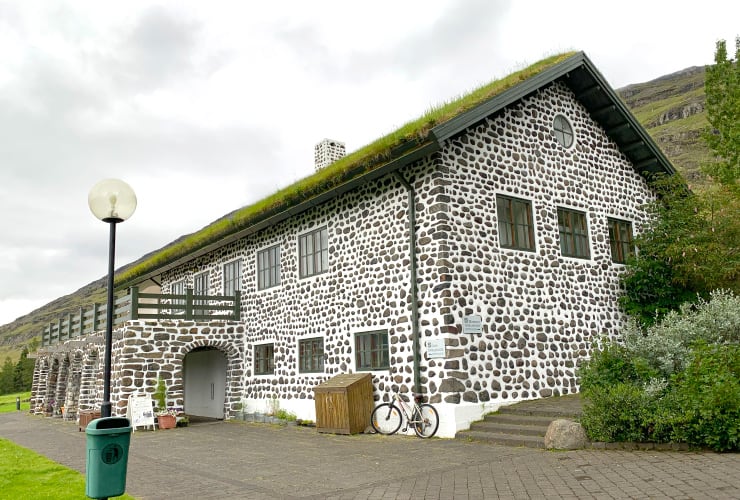
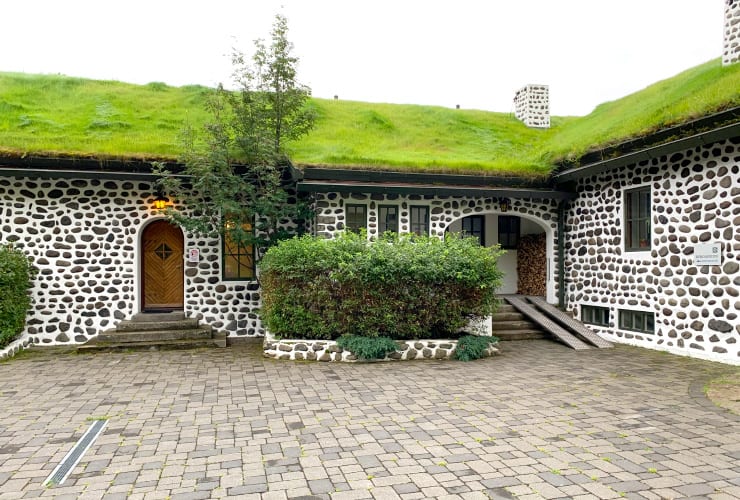
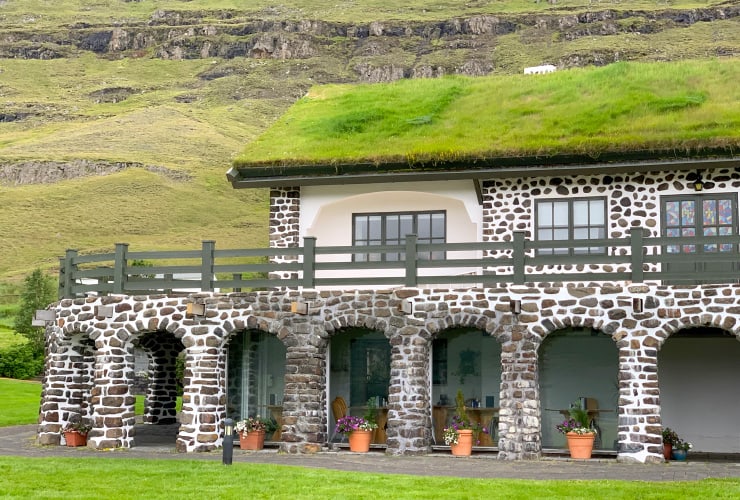
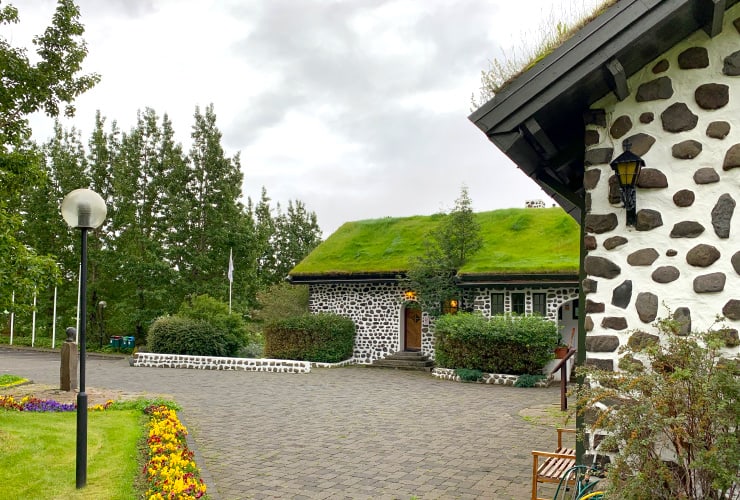
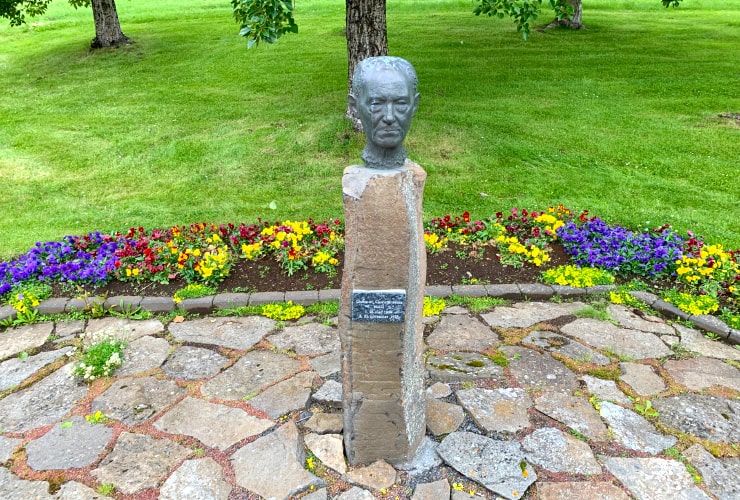
Late on our 4th day our guide took us to Skriðuklaustur, the former home of noted Icelandic author Gunnar Gunnarsson. If you enjoy architecture Skriðuklaustur is one of the best Iceland towns and historic places to visit. The exterior of the home features Laufás turf roofs and distinctive white walls embedded with dark stones overlooking the Logurinn lake. The home has been converted into a museum and school and even has an excellent restaurant, Klausturkaffi. On the southeast corner of the property are the remains of a 16th century monastery that were unearthed over a ten year period at the beginning of the 21st century. Even if you can only walk around the mansion it is well worth the visit.
Glaumbær Farm & Museum
Pronounced: clume • bahsh
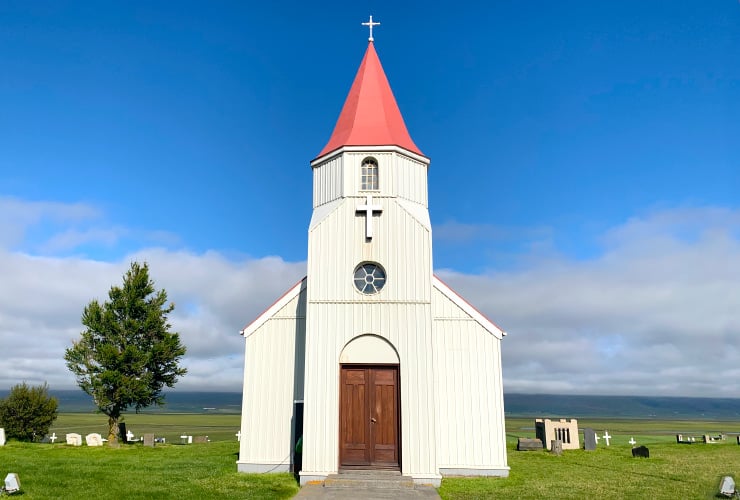
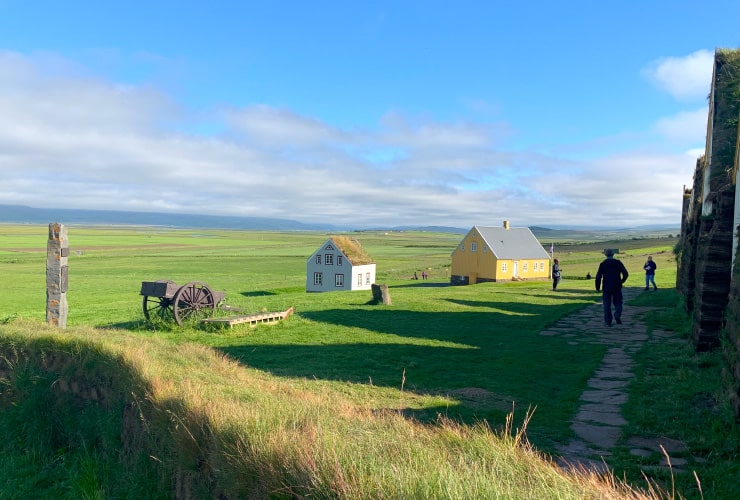
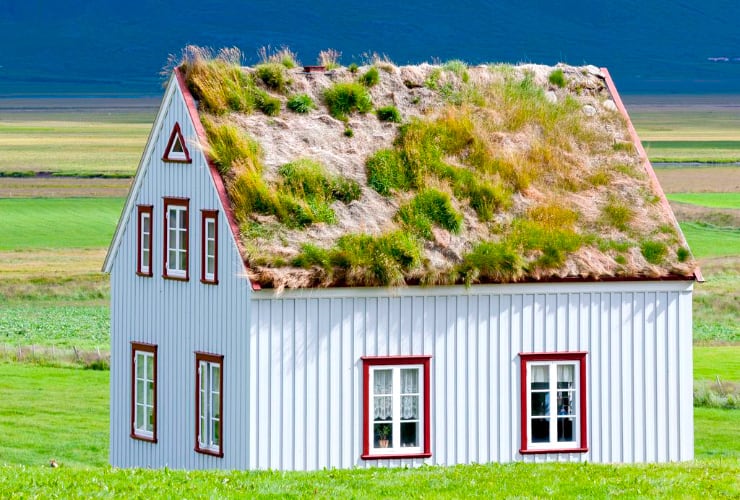
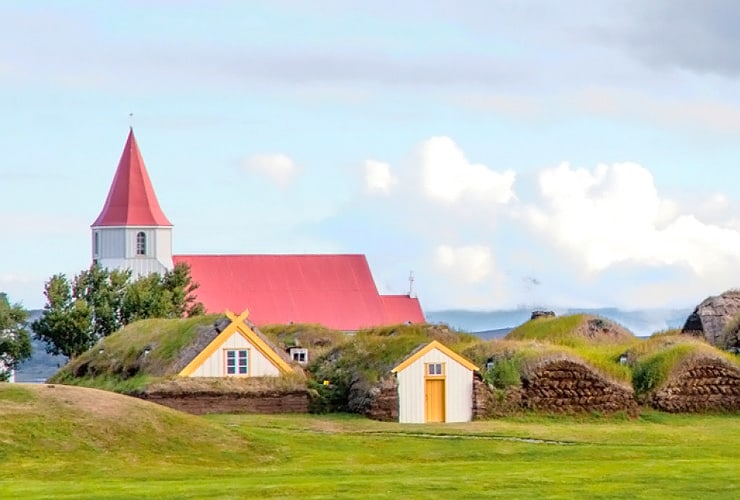
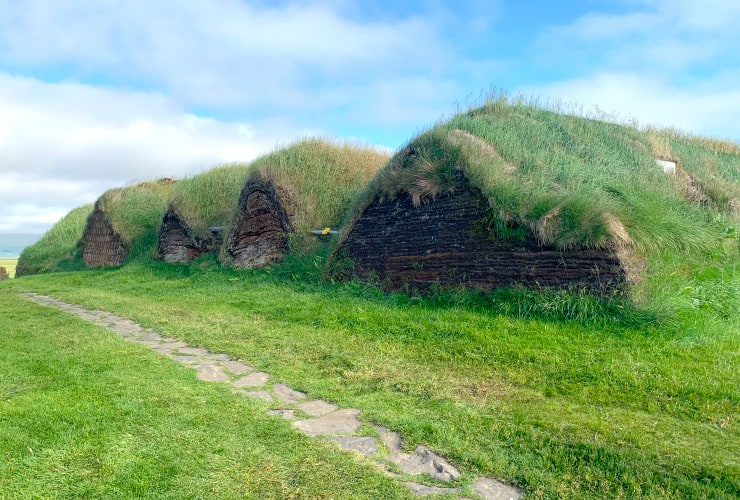
Just a few minutes north of the Ring Road in Skagafjörður is the fabulous Glaumbær Farm & Museum. Most famous for its Laufás turf roofs, Glaumbær also has a museum which celebrates the long history of the farm and a glimpse of 18th century life. The turf roofs became necessary due to a scarcity of adequate building materials like timber and stone, and it helped to fortify the structures against the harsh Icelandic climate. The first inhabitant of Glaumbær dates back to the late 9th century and was still operating as a functional farm until 1947 when it became a protected site and the National Museum of Iceland took over conservatorship. Directly in front of the parking lot is a quaint little church and graveyard that is worth a visit.

There truly is no end to the best Iceland towns and historic places to visit. The Icelandic history is filled with danger, excitement, monumental events and long stretches of isolation. Their history is easier to document than many other older cultures because their language, written and spoken, hasn’t changed over the last millennium.
Do you have a favorite Icelandic town or historic place? We’d love to hear all about it!

